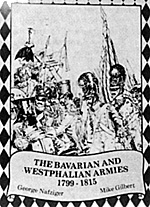
By George Nafziger and Mike Gilbert. Published by RAFM Co. Inc., 19 Concession St., Cambridge, Ont., Canada NIR 2G6. Copyright 1981. 67 pages, No Price Listed.
Napoleonics gamers have been luckier than gamers of many other periods of interest in that the detailed information they need to organize, paint and field their armies, and on which their rules must be designed, is available. Nevertheless, english language sources leave gaps in our knowledge of the Central European armies and their history in this era, and George Nafziger and Mike Gilbert, trained and practiced researchers familiar to many in the hobby, have produced a booklet combining data from years of German language translating and collection, covering the Bavarian and Westphalian Armies.
The book is divided into two general portions, one for each army. The Bavarian Army contains general sections on infantry, cavalry and artillery, plus coverage of smaller support arms, the pontoniers, engineers and gendarmerie. The section on each arm incorporated an organizational history, comments on the historical developments needed to understand organization changes, plus summaries of decrees affecting the army. Sections on infantry drill and equipment shed light on microtactical detail, while a detailed uniform guide illustrated by line drawings offers the modeller invaluable help.
The Westphalian Army section commences with a general historical sketch of the army as a whole, treating the Order of Battle of the entire army and the specific year to year changes as a whole. Sections on rank and staff functioning, rations, military training and weapons complete the next general area of interest. Thence comes a painting guide, divided by service arm, interspersed with company and battalion level organization and equipment. The infantry segment is followed by a useful section on light infantry and infantry operations and drill, and a sort of Sergeant Major's primer for infantry fire commands. The cavalry and artillery sections have similar sections on drill and practices, and comments on the "ancillary services" -Gendarmerie, Departmental Companies and National Guard, and the quasi militarized Veterans companies and Penal Corps complete the book.
The volume's bibliography covers most of the standard reference works, plus the rare or untranslated German works from which most of the data comes. The authors "hope that his volume will address the majority of the questions that even the most serious students of the military art will desire". It is this reviewer's estimation that their hope must remain unfulfilled, for a variety of reasons, and that its best use -and it is quite informative - is as a supplement to other works.
The problem with this volume is that it appears to fall between two stools: Too detailed, and lacking color plates, it is marginal as a uniform guide - the information is there, but several colored guides are as useful, plus giving the color values an artist must have. As an organization list is adequate as far as the theoretical strengths are needed. It does nt, however, list field strengths for the various Bavarian and Westphalian campaigns, nor, indeed, does it list the campaigns themselves in any detail.
Finally, although the information is available on the Order of Battle for both armies above the battalion and regiment, it is not included. The booklet is loosely formatted, with ample space for a few charts and list which would have allowed realistic formation of Bavarian and Westphalian Brigades, Divisions and Corps for game use or in tracing the historical participation of these formations -- the data was not included, however, and is needed to meet the goal of this volume.
In summary, if your aim is to select and paint a wargame army unit and you already possess uniform and standard color guides, this will tell which units were available in which years, though not when they served. If you seek to trace the activity of the two armies throughout the Napoleonic wars or have questions about strengths, areas of employment, effectiveness in comparison to other armies or customary brigade formations (or any drill above the company), you must wait, it isn't here. Since many of these questions form the majority of those which trouble this "serious student of the military art", I have to give this effort a passing mark, no more.
More Reviews
-
Embolos: Naval Warfare from Salamis to Actium (Rules)
GHQ 1/285 Modern Aircraft (figures)
Airpower 1/285 modern aircraft (figures)
Bavarian and Westphalian Armies 1799-1815 (book)
The Sudan 1884-1898 (booklet)
Campaign Figures 25mm 7YW (figures)
Elastolin Miniatures 40mm Medieval (figures)
Back to Table of Contents -- Courier Vol. III #6
To Courier List of Issues
To MagWeb Master Magazine List
© Copyright 1982 by The Courier Publishing Company.
This article appears in MagWeb (Magazine Web) on the Internet World Wide Web.
Other military history articles and gaming articles are available at http://www.magweb.com